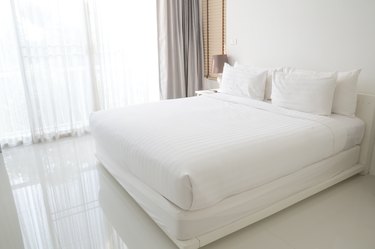
Are your bed sheets looking a lot more yellow than they did when you bought them? White bed sheets turn yellow because of age and regular usage as well as skin-care products, lotions, body oils, and sweat from your body. They work their way between the white sheets and cling to its cotton fibers. Adding bleach to the laundry load can yellow them even more because of oxidation and bleach's reaction with your body's fluids.
You can't help it that your body sweats at night when you sleep; it's part of the body's nature to do so. Body sweat, as it dries, is the most common reason white sheets and pillowcases turn yellow, but you may also notice a wet spot near your mouth on the pillow when you wake up. The unmentionable bodily fluids, along with saliva that escapes your mouth during sleep, also cause yellowing bed sheets.
Video of the Day
Video of the Day
Green Whitening Method
Add 1/2 cup of baking soda — not bleach — along with the detergent when you're washing white bed linens during the wash cycle. In place of fabric softener, which actually adds a waxy substance to linens and towels, making them nonabsorbent, pour in a 1/2 cup of vinegar during the rinse cycle or add it to your washing machine's fabric softener dispenser. Vinegar also acts as a laundry disinfectant to make your sheets extra clean. The vinegar smell rinses out, but the vinegar leaves sheets feeling soft when combined with the baking soda in the wash.
For an even greater whitening effect, hang white bed linens in the sun to dry, which leaves a naturally fresh smell on the sheets. If they come out a little stiff after drying them outside, simply toss them in the dryer on the wrinkle-release setting to soften them up.
Borax Whitening Method
Soaking the sheets in borax can help whiten them before you put them through the normal wash cycle. Combine 1/2 cup of borax with a gallon of water. You can double or triple the solution if you need more. Completely submerge and soak the sheets in the borax solution overnight to give them plenty of time in the laundry whitening booster.
Wring most of the water out of the sheets and put them in the washing machine with detergent like normal. Allow the machine to go through the wash and rinse cycles. When it's done, set the washer on the rinse cycle one final time. Hang the sheets outside to dry in the sun, softening them in the dryer to remove wrinkles or stiffness.
Liquid Bluing Method
It might seem like liquid bluing would make the white sheet situation worse, but it can help counteract the yellowing and restore a whiter look to your sheets. Don't pour the liquid bluing directly onto the sheets as it can cause stains. You'll need to dilute it according to the package instructions, often at a rate of 1/4 teaspoon bluing to 1 quart of cold water. You can then add the diluted liquid bluing to your washing machine along with the sheets and your regular detergent for a normal wash cycle.
Preventing Yellowed Sheets
Many natural bleaching options can keep your sheets white each time you wash them. Wash your sheets frequently to prevent yellowing and add one of the following bleaching agents to the load:
- Baking soda
- White distilled vinegar
- Hydrogen peroxide
- Lemon juice
- Oxygen bleach
Only wash white sheets and linens in the load; don't add colored items to the mix. Avoid overloading the washing machine, which can make it difficult to get the sheets clean. Hang the freshly washed outside in the sun to dry on a clothesline.